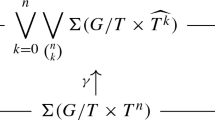Abstract
We propose new sufficient conditions for \(L^p\)-multipliers on homogeneous nilpotent groups. The multipliers generalise the flag multipliers of Nagel–Ricci–Stein–Wainger, but the approach and the techniques applied are entirely different. Our multipliers are better adapted to the specific commutation rules on the Lie algebra of the given group. The proofs are based on a new symbolic calculus fashioned after Hörmander. We also take advantage of the Cotlar–Stein lemma, and the Littlewood–Paley theory in the spirit of Duoandikoetxea–Rubio de Francia.
Similar content being viewed by others
References
Chevalley, C.: Theory of Distributions. Columbia University, Columbia (1950/1951)
Christ, M.: The strong maximal function on a nilpotent group. Trans. Am. Math. Soc. 331, 1–13 (1992)
Corwin, L., Greenleaf, F.P.: Representations of Nilpotent Lie Groups and Their Applications. Basic Theory and Examples. Cambridge University Press, Cambridge (1990)
Duoandikoetxea, J., de Francia, R.: Maximal and singular integral operators via Fourier transform estimates. Inv. Math. 84, 541–561 (1986)
Dziubański, J.: Schwartz spaces associted with some non-differential convolution operators on homogeneous groups. Colloq. Math. 63, 153–157 (1992)
Dziubański, J.: A note on Schrödinger operators with polynomial potentials. Colloq. Math. 78, 149–161 (1998)
Głowacki, P.: The Melin calculus for general homogeneous groups. Ark. Mat. 45, 31–48 (2007)
Głowacki, P.: \(L^p\)-boundedness of flag kernels on homogeneous groups via symbolic calculus. J. Lie Theory 23, 953–977 (2013)
Hörmander, L.: The Weyl calculus of pseudodifferential operators. Commun. Pure Appl. Math. 32, 359–443 (1979)
Manchon, D.: Formule de Weyl pour les groupes de Lie nilpotents. J. Reine Angew. Math. 418, 77–129 (1991)
Melin, A.: Parametrix constructions for right-invariant differential operators on nilpotent Lie groups. Ann. Glob. Anal. Geom. 1, 79–130 (1983)
Nagel, A., Ricci, F., Stein, E.M.: Singular integrals with flag kernels and analysis on quadratic CR manifolds. J. Funct. Anal. 181, 29–118 (2001)
Nagel, A., Ricci, F., Stein, E.M., Wainger, S.: Singular integrals with flag kernels on homogeneous groups I. Rev. Mat. Iberoam. 28, 631–722 (2012)
Narasimhan, R.: Analysis on Real and Complex Manifolds, Masson & CIE, Editeur-Paris. North-Holland Publishing Company, Amsterdam (1968)
Stein, E.M.: Harmonic Analysis. Princeton University Press, Princeton, NJ (1993)
Acknowledgements
I wish to thank L. Newelski, M. Pascu, and E. M. Stein for their advice on the subject of the paper.
Author information
Authors and Affiliations
Corresponding author
Additional information
Communicated by Hans G. Feichtinger.
Appendix: Convolution of Distributions
Appendix: Convolution of Distributions
Let X be an N-dimensional vector space as described in Sect. 2.
10.1
(Sobolev inequality) We have
where \( \Vert f\Vert _{A(X)}=\int _{\mathfrak {g}^{\star }}|\widehat{f}(\xi )|d\xi \). (Proposition 3.5.14 of Narasimhan [14].)
The following is a direct consequence of (10.1).
10.2
Let F be a measurable function on an open subset of X. If, for every \(\alpha \in \mathcal {A}_{\varvec{N}}\), \(D^{\alpha }F\) is a locally bounded function, then F is smooth.
Let \(\mathfrak {g}\) be a nilpotent Lie group as described in Sect. 5. The following definition of the general convolution is due to Chevalley. See Chevalley [1], Sect. 8.
Definition 10.3
We say that distributions \(S,T\in \mathcal {S}'(\mathfrak {g})\) are convolvable if
Proposition 10.4
If S,T are convolvable, then there exists a unique distribution \(S\star T\) such that
10.6
If \(S,T\in \mathcal {S}'(\mathfrak {g})\) are convolvable, then
for \(\varphi \in \mathcal {S}(\mathfrak {g})\). Moreover, \(\widetilde{T}\) and \(\widetilde{S}\) are also convolvable and
10.8
A distribution \(R\in \mathcal {S}'(\mathfrak {g})\) is said to be an \(\mathcal {S}\)-convolver if \(R\star f,f\star R\in \mathcal {S}(\mathfrak {g})\), for every \(f\in \mathcal {S}(\mathfrak {g})\).
10.9
If \(K\in \mathcal {S}'(\mathfrak {g})\) and R is an \(\mathcal {S}\)-convolver, then K,R and R,K are convolvable and
10.10
A distribution \(R\in \mathcal {S}'(\mathfrak {g})\) is central if \(R\star f=f\star R\), for every \(f\in \mathcal {S}(\mathfrak {g})\). If R is a central \(\mathcal {S}\)-convolver, then \(R\star K=K\star R\), for every \(K\in \mathcal {S}'(\mathfrak {g})\).
10.11
If S and T are convolvable and R is an \(\mathcal {S}\)-convolver, then S, \(T\star R\) and \(R\star S\), T are convolvable, and
If, moreover, R is central, then
Rights and permissions
About this article
Cite this article
Głowacki, P. \(L^p\)-Multipliers Sensitive to the Group Structure on Nilpotent Lie Groups. J Fourier Anal Appl 25, 1632–1672 (2019). https://doi.org/10.1007/s00041-018-9640-4
Received:
Published:
Issue Date:
DOI: https://doi.org/10.1007/s00041-018-9640-4
Keywords
- Homogeneous groups
- \(L^p\)-multipliers
- Fourier transform
- Symbolic calculus
- Hörmander metrics
- Singular integrals
- Flag kernels
- Littlewood–Paley theory



